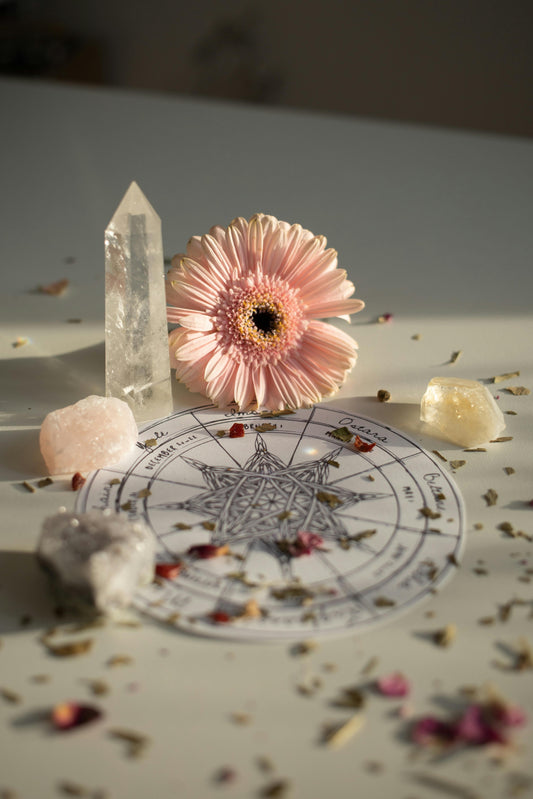Dear Saint Brigid of the kine, bless this little field of mine,
The pastures and the shady trees, bless the butter and the cheese.
Bless the cows with coats of silk, and the brimming pails of milk.
Bless the hedgerows and I pray, bless the seed beneath the clay.
Bless the hay and bless the grass, bless the seasons as they pass.
And Heaven’s blessings will prevail, Brigid, Mary of the Gael.
— John Irvine, The Treasury of Irish Saints
Imbolc Blessings!
The beginning of February — when the Sun reaches 15° of Aquarius — marks the midway point between the Midwinter Solstice and the Vernal Equinox and denotes a subtle, yet palpable, shift from winter to spring.
From this point onward the sunrise takes place two minutes earlier each day — a welcome reminder that the darkest days of winter are indeed behind us and the brighter days of spring and summer lay ahead.
Imbolc
On the nature-based Wheel of the Year we celebrate the Celtic fire festival of Imbolc — one of four cross-quarter holy days celebrating the perpetual cycles of Earth’s seasons.
Its name comes from the Gaelic word Imbolg, meaning in the belly. It refers to the time of year when ewes are carrying their lambs. Seeds, bulbs, and roots are awakening in the belly of the Earth, and all of life is pregnant with hidden possibility and potential.
Imboc's Connection to Brigid's Day
Imbolc is associated with both the ancient goddess and Irish saint of the same name: Brigid. And it generally coincides with the birth, death, and feast day of St Brigid of Kildare on February 1.
Brigid's Many Names and Manifestations
Brigid is a beloved figure worldwide but is particularly adored in Ireland and western Europe where she’s venerated as Muire na nGael — Mary of the Gael. Both the goddess and saint are equally honored at Imbolc.
Because of her widespread veneration, Brigid’s name has multiple spellings and pronunciations. Brighid or Bríd is historically pronounced with either a hard or silent G — BRIGG-id, BREE-id or Bride, but is also often pronounced with a J sound — BRIJ-id — meaning Exalted or High One (or Fiery Arrow according to some translations).
Brigid’s stories are rich and miraculous and her associations are many. Taken as a whole, the various manifestations of Brigid weave an intricate tapestry of beauty, warmth and inspiration.
As a saint, Brigid was formally made a patron of Ireland in 1962, but her worship as a goddess dates back some 1,900 years to around 71 AD — and possibly earlier. Her predecessor, the goddess Brigantia was worshipped in northern England before migrating and transforming into the Goddess Brigid when displaced Brigantian Druid’s arrived in Ireland and merged with the local population. She later evolved into the Vodou lwa, Maman Brigitte (Mother Brigitte), when Scottish and Irish indentured servants were transported to the Caribbean — always transforming herself to meet the needs of her people.
In 2022 the widespread observance of St Brigid’s Day in Ireland was declared a nationally-recognized holiday — the first to officially acknowledge the Divine Feminine in modern times — rather appropriate for a country named after a goddess — the Goddess Ériu.
The Three Fires and Faces of Brigid
As a triple goddess (a goddess that appears as three sisters or as one goddess with three distinct spheres of influence) she kindles the creative fires of the poet, the transformative fires of the forge, and the life-sustaining fires of the hearth.
Brigid is a wise woman of compassion. She heals, advises and nurtures all who come to her in times of need.
Brigid's Associations
Brigid is a goddess and patroness of women and children, fertility and abundance, childbirth and rebirth, babies and breastfeeding, midwifery and poetry, protection and prophecy, milk and ale, weaving and healing, hospitality and sovereignty, ceremonial fires and holy well waters, keening grief and radical transformation, snowdrops and dandelions, a threadbare cloak and the Church of the Oak, the dawn of enlightenment and the perpetual flame of inspiration, invention, peace and possibility.
Brigid's Archetypal Qualities
As an archetypal aspect of Self, Brigid represents the ability to integrate and harmonize the tension of opposites. She elegantly bridges the threshold of masculine and feminine, fire and water, winter and summer, pagan and christian, snake and swan, lamb and fox, pain and ecstasy, rebellious daughter and dignified saint, mortality and divinity, high ideals and simple pleasures, old world order and new earth paradigm.
Cosmic Brigid
In 2008 astrologers made a mysterious discovery: The locations of St Brigid’s many sacred sites — from the Holy Well in Faughart, to Brigid’s Fire Temple and Holy Well in Kildare — are perfectly mapped by the stars of the cross-shaped Cygnus constellation as it would have appeared in the ancient night sky over Ireland at the time of her birth and the arrival of Christianity in Ireland in the fifth century.
Located in the dark rift of the Milky Way Galaxy, the Cygnus (swan) constellation is situated in what some consider to be the point of life’s cosmic origins — the portal in and out of the sky world — the birthing womb of creation. Furthermore the Deneb star of the Cygnus constellation appears to emit neutrally-charged cosmic rays — affectionately called cygnets — possibly responsible for penetrating, mutating and evolving human DNA — perhaps connecting Brigid to the energies of the Great Cosmic Mother Goddess of all life in the Universe and to the emergence of the coming new human.
Brigid's Way Pilgrimage
Devotees are invited to walk in Brigid’s footsteps, commune with the sacredness of earth and sky, and experience the deep and enduring spiritual heritage of her sacred sites firsthand, as they traverse the ethereal Irish countryside of The Brigid’s Way Pilgrimage. The ancient ritual practice of pilgrimage is more relevant today than ever as a way to restore balance and harmony to the individual psyche and to that of a world in need.
Brigid's Day
St Brigid’s Feast Day was traditionally celebrated from sundown on the evening of January 31 — St Brigid’s Eve (Oíche Fhéile Bhríde) — and continued until sundown on St Brigid’s Day (Fhéile Bhríde) on February 1. The observance of Candlemas (or the Feast of the Purification of the Virgin Mary) was celebrated the following day, February 2, with various stories of Mary declaring that Brigid’s Feast Day should come before her own as thanks for Brigid aiding Mary in her time of need.
Traditional Celebrations
In historical agrarian society, celebrations of Imbolc and St Brigid’s Day always consisted of rituals to petition blessings on the crops, animals and general household.
The range and number of customs and beliefs concerning St Brigid is almost certainly greater than those attached to any other saint. — Brian Wright, Brigid: Goddess, Druidess and Saint
Some traditional customs included:
- making and parading a straw Bhrideog (little Brigid) from house-to-house
- cleansing and preparing the home
- ceremonially welcoming a Bríd Óg (a Young Brigid played by a young girl carrying rushes or straw) at the front door while sending old stagnant energies out the open back door
- setting a place of honor for Brigid at the supper table and feasting on celebratory foods accompanied by requisite butter
- weaving the Crois Bhríde (Brigid’s Cross) from straw, reeds or rushes to be hung over the door for luck and protection
- leaving offerings of food and fodder for Brigid and her otherworldly white cow on the doorstep
- and placing articles of clothing, cloth, or silk ribbons outdoors to catch the morning dew or hoar frost and Brigid’s touch to infuse them with the magical healing and protective powers of her blackberry-stained cloak thereby becoming a Bhrat or Ribín Bhríde for use in the year to come
Everything possible was done to make the house warm and cozy for the coming celebration and to welcome the saint’s presence into the dwelling. — Brian Wright, Brigid: Goddess, Druidess and Saint
Modern Celebrations
Today’s celebrations of Imbolc and St Brigid’s Day feature community gatherings, celebratory bonfires, weaving and displaying Brigid’s Cross, visiting Brigid’s holy wells, making offerings, enjoying music, storytelling, feasting and general merrymaking to commemorate the goddess-saint and the coming of springtime.
Invitation
Imbolc and St Brigid’s Day offer a potent opportunity for modern mothers to intentionally celebrate the wisdom of the Divine Feminine.
Invite Brigid’s essence to infuse your motherhood with mystery, magic, meaning and significance as you seek to serve life and re-enchant the world from the depths of your sacred heart and soul.
Brigid’s gifts lie not in what she brings to you, but rather in casting light on what you can bring to the world. — Michelle Skye
Once Brigid sets her sights on you, your life is irrevocably changed for the better.
Your Turn: Simple Ways to Celebrate Imbolc and Brigid's Day
- Journal Prompts: What does Brigid’s archetype inspire within me? What gifts does she urge me to share with the world?
- Craft a poem to celebrate the season.
- Start your spring cleaning. Make a list of all the tasks you’d like to tackle and see how many you can check off.
- Enjoy Irish Colcannon Potatoes or Boxty with ample butter.
- Churn your own butter!
- Have a beer and drink to your health in Brigid’s name. Read and contemplate the sentiments in Brigid’s Lake of Beer prayer.
- Weave a Brigid‘s Cross.
- Make a Bhrat or Ribín Bhríde. Tie a berry-colored cloth or ribbon outside on Brigid’s Eve to acquire Brigid’s blessings. Bring it inside first thing in the morning and store it in a special place. Use as needed for healing and protection throughout the year.
- Make, dress, and decorate a Bhrideog (little Brigid) and place in a bed to welcome Brigid’s blessings to reside in your home.
- Read stories about Brigid and her miracles.
- Listen to our Imbolc • Brigid’s Day playlist to align with the magic and mystery of Brigid’s powerful archetypal energies
Brigid, bright and fiery arrow, blaze into my life.
Sainted bringer of spring, grow ever more verdant and lush.
Mistress of poetry and craft, dance on my tongue and in my hands.
Guardian of the wells, waters and herbs, warm my hearth and home, and open the doors of my heart to compassion.
Thank you Exalted One for the nourishment of milk and words, for the protection of your threadbare cloak, for the peace that abides in your care.
Bless you for the sacred fires and the thawing earth.
Brigid, I promise my best effort and my lightest laugh in your name.
TELL US: How do you celebrate Imbolc and Brigid’s Day?




